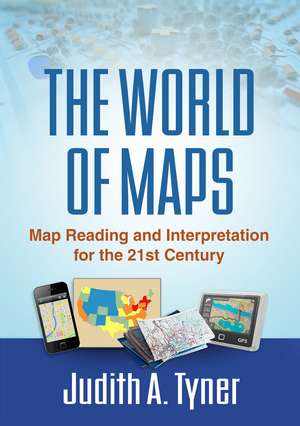The World of Maps: Map Reading and Interpretation for the 21st Century
Autor Judith A. Tyneren Limba Engleză Hardback – 19 noi 2014
Maps have power--they can instruct, make life easier, mislead, or even lie. This engaging text provides the tools to read, analyze, and use any kind of map and assess its strengths and weaknesses. Requiring no advanced math skills, the book presents basic concepts of symbolization, scale, coordinate systems, and projections. It gives students a deeper understanding of the types of maps they encounter every day, from turn-by-turn driving directions to the TV weather report. Readers also learn how to use multiple maps and imagery to analyze an area or region. The book includes 168 figures, among them 22 color plates; most of the figures can be downloaded as PowerPoint slides from the companion website. Appendices contain a glossary, recommended resources, a table of commonly used projections, and more.
Preț: 351.09 lei
Preț vechi: 464.34 lei
-24% Nou
Puncte Express: 527
Preț estimativ în valută:
67.18€ • 70.32$ • 55.92£
67.18€ • 70.32$ • 55.92£
Comandă specială
Livrare economică 10-24 martie
Doresc să fiu notificat când acest titlu va fi disponibil:
Se trimite...
Preluare comenzi: 021 569.72.76
Specificații
ISBN-13: 9781462516483
ISBN-10: 1462516483
Pagini: 237
Dimensiuni: 178 x 254 x 20 mm
Greutate: 0.66 kg
Ediția:1
Editura: Guilford Publications
Colecția Guilford Press
ISBN-10: 1462516483
Pagini: 237
Dimensiuni: 178 x 254 x 20 mm
Greutate: 0.66 kg
Ediția:1
Editura: Guilford Publications
Colecția Guilford Press
Cuprins
I. Map Reading Basics
1. Introduction: The Importance of Map Reading
2. Landmarks of Mapmaking
3. Map Basics
4. The Figure of the Earth and Coordinate Systems
5. Map Projections: The Round Earth on Flat Paper
6. The Earth from Above: Remote Sensing and Image Interpretation
II. Map Types and Their Analysis
7. Virtual Maps and GPS
8. Topographic Maps
9. Thematic Maps
10. Maps for Navigation
11. Maps for Special Purposes
III. Putting It All Together
12. Map Interpretation
13. Epilogue: The Future of Maps and Map Reading
Appendix A. Glossary
Appendix B. Abbreviations
Appendix C. Useful Statistics
Appendix D. Resources
Appendix E. Commonly Used Projections
Bibliography
1. Introduction: The Importance of Map Reading
2. Landmarks of Mapmaking
3. Map Basics
4. The Figure of the Earth and Coordinate Systems
5. Map Projections: The Round Earth on Flat Paper
6. The Earth from Above: Remote Sensing and Image Interpretation
II. Map Types and Their Analysis
7. Virtual Maps and GPS
8. Topographic Maps
9. Thematic Maps
10. Maps for Navigation
11. Maps for Special Purposes
III. Putting It All Together
12. Map Interpretation
13. Epilogue: The Future of Maps and Map Reading
Appendix A. Glossary
Appendix B. Abbreviations
Appendix C. Useful Statistics
Appendix D. Resources
Appendix E. Commonly Used Projections
Bibliography
Notă biografică
Judith A. Tyner, PhD, is Professor Emerita of Geography at California State University, Long Beach. She taught in the Geography Department for over 35 years, where she served as Department Chair and as Director of the Cartography/GIS Certificate Program from its inception until her retirement. While at California State Dr. Tyner taught beginning and advanced cartography, map reading and interpretation, history of cartography, and remote sensing. She is a member of the Association of American Geographers, the North American Cartographic Information Society, the Cartography and Geographic Information Society, and the California Map Society. She is the author of several textbooks, including Principles of Map Design, and over 30 articles.
Recenzii
“Tyner has done it again--she has crafted an accessible book that makes reading about maps not only educational but fun! Here she convinces us that even as maps move from paper onto the Web and mobile devices, knowing how to use them and understanding how they work is as important as ever. By clearly differentiating map reading from map analysis, Tyner ably covers the concepts needed to become proficient in map interpretation and spatial thinking. This is a suitable text for introductory map and spatial analysis classes.”--Ian Muehlenhaus, PhD, Department of Integrated Science and Technology, James Madison University
"This is a broad-based introduction to map use, reading, and interpretation. While it could be read cover to cover, its strength is in providing concise, stand-alone descriptions and explanations of map types and mapping conventions that are sufficiently detailed without being overwhelming. Tyner’s expertise as an instructor is evident in her conversational discussions of highly technical and specialized topics; her style will put nonexpert readers quickly at ease as she does not rely on technical terms or jargon. World of Maps could be a recommended text for students who are interested in exploring maps and map use, and students in a wide variety of disciplines that incorporate spatial thinking, display, or analysis. It will also find a home in many college and university libraries as a go-to resource."--Jenny Marie Johnson, Maps and Geography Librarian and School of Earth, Society, and Environment, University of Illinois at Urbana-Champaign
"Investigating whether maps are obsolete, Tyner makes a compelling case for the importance of maps in humankind’s past and future and the need for increased cartographic literacy. She writes in a manner that is both entertaining and informative. The extensive bibliography and appendices will help make this book a treasured resource for geographic education. The level is suitable for those engaged in formal study of spatial techniques as well as for neocartographers."--Eugenie Rovai, PhD, Department of Geography and Planning, California State University, Chico-This is a concise introduction to a rich and complex topic, useful for an elementary map reading course. Recommended. Lower-division undergraduates and general readers.--Choice Reviews, 5/1/2015
Descriere
Maps have power--they can instruct, make life easier, mislead, or even lie. This engaging text provides the tools to read, analyze, and use any kind of map and assess its strengths and weaknesses.
